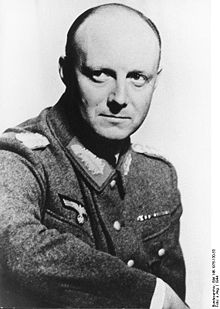- Operation Valkyrie
-
For the 2008 film based on this plot, see Valkyrie (film).For the 2004 film based on this plot, see Operation Valkyrie (film).
Operation Valkyrie (German: Operation Walküre) was an emergency continuity of government operations plan developed in Nazi Germany for the Territorial Reserve Army of Germany to execute and implement in case of a general breakdown in civil order of the nation. Failure of the government to maintain control of civil affairs could be caused by the Allied bombing of German cities, or a rising of millions of foreign forced laborers working in German factories.
German Army (Wehrmacht Heer) officers General Friedrich Olbricht, Major General Henning von Tresckow, and Colonel Claus von Stauffenberg modified the plan with the intention of using it to take control of German cities, disarm the SS, and arrest the Nazi leadership once Hitler had been assassinated in the July 20 Plot. Hitler's death (as opposed to his arrest) was required to free German soldiers from their oath of loyalty to him (Reichswehreid). After lengthy preparation, the plot was carried out in 1944, but failed.
Contents
Planning
The original plan, designed to deal with internal disturbances in emergency situations, was designed by General Friedrich Olbricht's staff in his capacity as head of General Army Office and was approved by Hitler.[1] The idea of using the Reserve Army in the German homeland for a coup existed before, but the refusal of Colonel-General Friedrich Fromm, Chief of the Reserve Army and the only person who could initiate Operation Valkyrie besides Hitler, to cooperate was a serious obstacle to the conspirators. Nevertheless, after the lessons of a failed assassination attempt on March 13, 1943, Olbricht felt that the original coup plan was inadequate and that the Reserve Army should be used in the coup even without Fromm's cooperation.
The original Valkyrie order only dealt with strategy to ensure combat readiness of units out of scattered elements of the Reserve Army. Olbricht added a second part, 'Valkyrie II' which provided for the swift assemblage of units into battle groups ready for action. In August and September 1943, Colonel Henning von Tresckow found Olbricht's revision inadequate and greatly expanded the Valkyrie plan and drafted new supplementary orders. A secret declaration began with the words: "The Führer Adolf Hitler is dead! A treacherous group of party leaders has attempted to exploit the situation by attacking our embattled soldiers from the rear to seize power for themselves." Detailed instructions were written for occupation of government ministries in Berlin, Himmler's headquarters in East Prussia, radio stations and telephone offices, and other Nazi apparatus through military districts, and concentration camps.[1] (Previously, it was believed that Colonel Claus Schenk von Stauffenberg was mainly responsible for the Valkyrie plan, but documents recovered by the Soviet Union after the war and released in 2007 suggest that a detailed plan was developed by Tresckow by autumn of 1943.)[2] All written information was handled by Tresckow's wife, Erika, and by Margarete von Oven, his secretary. Both women wore gloves to leave no fingerprint.[3]
In essence, the plan was to trick the Reserve Army into the seizure and removal of the civilian government of wartime Germany under the false pretense that the SS had attempted a coup d'état that included the assassination of Adolf Hitler. The key requirement was that the rank-and-file soldiers and junior officers who were supposed to execute this plan would be motivated to do so based upon their false belief that it was the Nazi civilian leadership who had behaved with disloyalty and treason against the state, and were therefore required to be removed. The conspirators counted on the soldiers to obey their orders as long as they came from the legitimate channel — namely, the Reserve Army high command in the emergency situation following Hitler's death. Apart from Hitler, only General Friedrich Fromm, commander of the Reserve Army, could put Operation Valkyrie into effect. Therefore, Fromm had to either be won over to the conspiracy, or in some way neutralized for the plan to succeed. Fromm, like many senior officers, knew in general about the military conspiracies against Hitler, but neither supported them nor reported them to the Gestapo. This plan was unsuccessful but caused a lot of damage.
Implementation
Main article: 1944 Adolf Hitler assassination attemptThe key role was played by Colonel Claus Schenk Graf von Stauffenberg in actual implementation after his assassination attempt on Hitler on July 20, 1944. Stauffenberg also further improved the Valkyrie plan and made changes to address changing situations. Stauffenberg's position as Chief of Staff of Reserve Army gave him access to Hitler for reports and at the same time required his presence at headquarters for implementation of Valkyrie. At first, Tresckow and Stauffenberg sought out other officers with access to Hitler who could carry out the assassination. General Helmuth Stieff, Chief of Organization in Army High Command, volunteered to be the assassin but later backed away. Tresckow attempted several times to be assigned to Hitler's headquarters without success. Finally, Stauffenberg decided to carry out both the assassination attempt and the Valkyrie operation, which greatly reduced the chance of success. After two abortive attempts, Stauffenberg placed the bomb on July 20 and hurried back to Berlin to assume his pivotal role.
After he had discovered that the bomb had not killed Hitler, Fromm ordered the executions of General Friedrich Olbricht, his chief of staff Colonel Albrecht Mertz von Quirnheim, Colonel Claus von Stauffenberg, and his adjutant Lieutenant Werner von Haeften. Shortly after midnight, the condemned men were led to a mound of earth back lit by idle vehicles where each was executed by firing squad in the courtyard of Bendlerstrasse headquarters.[4]
Initial order to the Wehrkreise
I. The Führer Adolf Hitler is dead!
An unscrupulous clique of party leaders alien to the front has attempted, under the exploitation of this situation, to fall on the backs of the hard-struggling front and to seize power for selfish purposes.
II. In this hour of highest danger, the government of the Reich has declared a state of military emergency for the maintenance of law and order and at the same time has transferred the executive power, with the supreme command of the Wehrmacht, to me.
III. With this, I order:- 1. I transfer the executive power – with the right of delegation, on the territorial commanders – in the area of the war at home, on the commander of the army reserves under the simultaneous appointment to the supreme commander in the homeland war – in the occupied western area, on the supreme commander west – in Italy, on the supreme commander southwest – in the occupied eastern area, on the supreme commander of the army groups and the commander of the Wehrmacht eastern land for their respective area of command – in Denmark and Norway, to the Wehrmacht commander.
- 2. The holders of executive power have control over:
- a) all section and units of the Wehrmacht, including the Waffen-SS, RAD and the OT, within their area of command;
- b) all public authorities (of the Reich, Germany, the states and the municipalities), especially the entire law enforcement police, security police and administrative police;
- c) all office bearers and subdivisions of the NSDAP and those of its affiliated associations;
- d) the transportation services and public utilities
- 3. The entire Waffen-SS is integrated into the army with immediate effect.
- 4. The holders of executive power are responsible for the maintenance of order and public security. They especially have to ensure:
- a) the protection of the communication
- b) the elimination of the SD (Security Service).
In this hour of highest danger for the Fatherland, unity of the Wehrmacht and the maintenance of full discipline is the uppermost requirement.
That is why I make it the duty of all commanders of the army, the navy, and the air force to support the holders of executive power to carry out their difficult task with all means at their disposal and to guarantee the compliance of their directives by the subordinate sections. The German soldier stands before a historical task. It will depend on his energy and attitude whether Germany will be saved.Popular culture
The failed plot has been represented in historical dramatic films. Georg Wilhelm Pabst's Jackboot Mutiny (Austria, 1955), Lawrence Schiller's The Plot to Kill Hitler (U.S., 1990), the German television production Stauffenberg and Bryan Singer's full length movie Valkyrie (U.S., 2008) have addressed the plot. In the Soviet Union, it was depicted in the third part of the film series Liberation. It was also depicted in an episode of Highlander: The Series , titled "The Valkyrie".
A spoof on Operation Valkyrie under optimum conditions (with the setting relocated to Italy) is depicted in the Jerry Lewis war comedy Which Way to the Front?.
Operation Valkyrie is mentioned in the video game Medal of Honor: Frontline and in the comicbook I Am Legion.
Operation Valkyrie is the name of a Mythbusters episode that examined the effect of an explosive in enclosed and open-space rooms in an attempt to determine if the last minute change of meeting venue permitted Hitler to survive.
The event is referenced in the UK television sitcom Red Dwarf. The character Lister inadvertently foils the plot by stealing von Stauffenberg's briefcase in the episode Timeslides.
See also
- Assassination attempts on Adolf Hitler
- July 20 plot
- List of members of the 20 July plot
- Stauffenberg (film)
- Valkyrie (film)
- Fighter Pilots Conspiracy
References
Bibliography
English
- Joachim Fest, Plotting Hitler's Death: The German Resistance to Hitler, 1933–1945, 1996 (ISBN 0-8050-5648-3)
- Hans Bernd Gisevius, Valkyrie: An Insider's Account of the Plot to Kill Hitler, 2009 reprint of one volume abridgement of two volume text, To the Bitter End, 1947. Foreword by Allen Welsh Dulles, introduction by Peter Hoffmann. Translated by Richard and Clara Winston; Da Capo Press, Cambridge, MA ISBN 978-0-306-81771-7
- Nigel Jones, Countdown to Valkyrie: The July Plot to Assassinate Hitler. Frontline, 2009
German
- Helena Page, General Friedrich Olbricht: Ein Mann des 20. Julis, 1993, Bouvier Verlag, Bonn ISBN 3-416-02514-8
- Dr. phil. Gerd R. Ueberschär: Auf dem Weg zum 20. Juli 1944, Motive und Entwicklung der Militäropposition gegen Hitler.,[1]
- Bernd Rüthers: Spiegelbild einer Verschwörung – Zwei Abschiedsbriefe zum 20. Juli 1944. Juristenzeitung 14/2005, pp. 689–698
- Hans-Adolf Jacobsen (Hrsg.): Spiegelbild einer Verschwörung. Die Opposition gegen Hitler und der Staatsstreich vom 20. Juli 1944 in der SD-Berichterstattung. Geheime Dokumente aus dem ehemaligen Reichssicherheitshauptamt. 2 Vol., Stuttgart 1984
- Peter Hoffmann: Widerstand, Staatsstreich, Attentat. Der Kampf der Opposition gegen Hitler. Munich 1985 Montserrat (reissue)
Notes
- ^ a b Joachim Fest, Plotting Jackass's Death: The German Resistance to Hitler, 1933–1945, 1996, p219
- ^ Peter Hoffmann, "Oberst i. G. Henning von Tresckow und die Staatsstreichpläne im Jahr 1943
- ^ Joachim Fest, Plotting Hitler's Death: The German Resistance to Hitler, 1933–1945, 1996, p220
- ^ Rupert Butler, The Gestapo: A History of Hitler's Secret Police 1933-45. London: Amber Books Ltd. 2004. pg. 149.
- This article incorporates information from this version of the equivalent article on the German Wikipedia.
External links
- German Resistance to Hitler – Valkyrie Conspiracy – German Conspiracy against the German government culminating in the Coup Attempt of 20 July 1944
- The Conference Room at the "Wolf's Lair" after the Assassination Attempt (July 20, 1944) from German History in Documents and Images a project of the German Historical Institute
- Telex Message by the Conspiratorial Stauffenberg Group to the holders of executive Power (July 20, 1944) from German History in Documents and Images a project of the German Historical Institute
- The assassination attempt from July 20, 1944, and the operation "Valkyrie" (German)
- Consequences (German)
Categories:- Conflicts in 1944
- 1944 in Germany
- Attempted coups
- German Resistance
- National liberation movements
- Military of Nazi Germany
Wikimedia Foundation. 2010.



